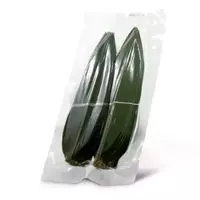Bamboo leaves

The Bamboo subfamily is assigned to the Zlakov family and has about 1, 200 different plant species. There are two main types of bamboo plants. Tribe bamboo or bamboo tree, as well as Olympic plants, which are more like grasses, thickets or shrubs. All varieties of bamboo plants differ in size. Usually, bamboo reaches a height of up to 20 meters. In many countries, bamboo plants are considered indispensable in both food and other industries.
In importance, ordinary bamboo (Bambusa arundinacea) can be compared with coconut palm. Almost all components of the palm tree are used by humans, as is the case with ordinary bamboo. Bamboo differs not only in its size, but also in its growth rate. Some varieties of the plant can add up to 120 cm in length per day. Bamboo belongs to tropical species, however, in addition to the mild climates of Asia, Africa, Australia and Latin America, some species of the plant feel great in quite diverse European weather conditions.
Herbaceous plants from the bamboo family grow exclusively in warm tropical or subtropical climates. People have long learned about the taste and benefits of bamboo. Therefore, young shoots, as well as bamboo leaves, are eaten. However, not all varieties of bamboo can be used in cooking. I often use bamboo leaves of species such as Dendrocalamus, Phyllostachys or Bambusa. As a rule, bamboo leaves are used in dried form as a seasoning for cooking Asian dishes.
For example, in Thailand, bamboo leaves are added to national soups, which are distinguished by a rich palette of taste due to a complex combination of various varieties of spices and spices. In addition to dried bamboo leaves, fresh plant greens are used in cooking. Usually fresh bamboo leaves are used as a kind of substrate for some Asian dishes. In Japan, meat and fish are wrapped in green bamboo leaves.
As a result, a kind of cabbage rolls are obtained, in which bamboo leaves are used instead of cabbage. Also, green bamboo leaves are added to vitamin vegetable salads. Science has established and proved the fact of the content of natural substances in young bamboo leaves that have powerful antiseptic and antimicrobial properties. Bamboo leaves are used as a constituent ingredient in some traditional Asian medicine products. It is believed that green bamboo leaves are an excellent preventive and therapeutic remedy for colds, as well as allergic reactions.
Bamboo leaves tone the human body, saturating with useful biologically active components that can prevent serious heart disease, as well as regulate digestive processes. In addition to cooking and traditional medicine, bamboo leaves are actively used in cosmetology. The silicic acids contained in bamboo leaves have a positive effect on the health of the skin, hair and nails. Also, a compress of bamboo leaves can speed up wound healing.
bamboo leaves 400 kCal
Energy value of bamboo leaves (Ratio of proteins, fats, carbohydrates - ju):
Proteins: 5 g (~ 20 kCal)
Fats: 10g (~ 90kCal)
Carbohydrates: 50g (~ 200kCal)
Energy ratio (bj | y): 5% | 23% | 50%
 Español
Español Français
Français Português
Português Русский
Русский 简体中文
简体中文 繁體中文
繁體中文 日本語
日本語 한국어
한국어 العربية
العربية Türkçe
Türkçe Қазақ
Қазақ Deutsch
Deutsch Italiano
Italiano Українська
Українська
